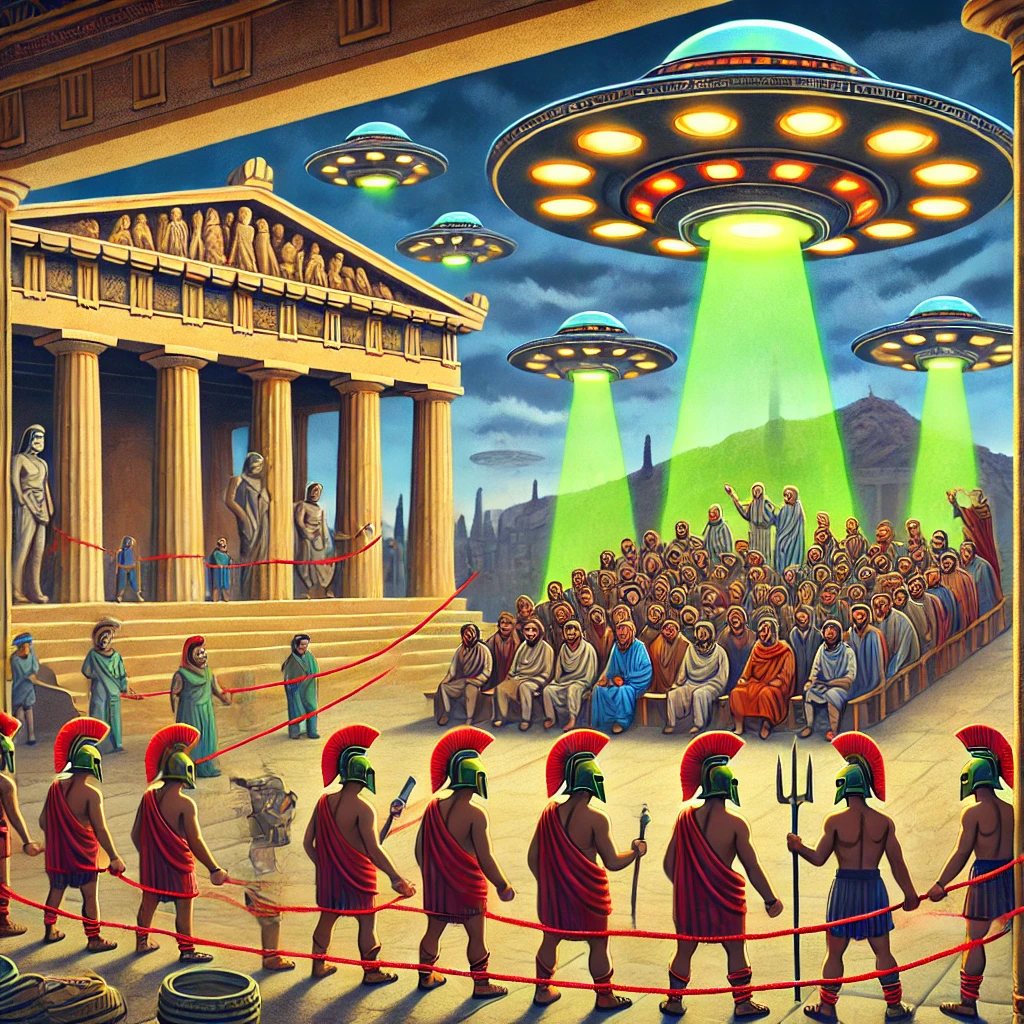Scientists have just discovered that UAPs (Unidentified Aerial Phenomena) are not only here, but they might be picky eaters. That’s right — after analyzing electromagnetic interference patterns from recent sightings, experts have suggested that UFOs might be scanning Earth for the perfect snack. Early theories indicate they’re bypassing kale and heading straight for our cheeseburgers. “Their refusal to land near vegan restaurants has baffled us,” said one researcher. “It’s almost… targeted.”
Let’s dive into the juicy details (pun intended) of this recent development.
The Culinary Connection
The revelation that aliens might be on Earth for culinary purposes has upended traditional thinking. Historically, we assumed UAPs were here for reconnaissance, resource extraction, or even cultural tourism (who wouldn’t want to hover over Stonehenge for a selfie?). But now, it seems their motives could be gastronomic. This theory gained traction after a series of bizarre incidents involving fast-food chains. In the Midwest, employees at a popular burger joint reported their grill temperatures fluctuating wildly while a glowing orb hovered overhead. Similarly, a taco truck in California experienced sudden outages during a UAP sighting, as if extraterrestrial forces were sampling the menu. Coincidence? We think not.
The Pentagon Responds
In light of these developments, the Pentagon has released a carefully worded statement: “We’re not saying they’ve come for Taco Tuesday… but we’re also not not saying that.” While officials remain tight-lipped, leaked documents hint at an intergalactic interest in deep-fried foods. Some reports describe UAPs lingering near state fairs, particularly around funnel cake stands. One anonymous source speculated, “It’s the powdered sugar. They’ve never seen anything like it.”
Meanwhile, skeptics argue that linking UAP activity to food preferences is a stretch. “These phenomena are likely surveying our planet for advanced technologies,” said one astrophysicist. “The idea that they’re drawn to barbecue sauce is absurd.” Yet, can we really rule out the possibility? After all, if humans explore the universe in search of habitable planets, why wouldn’t aliens search for interstellar cuisine?
The “Drive-Thru” Phenomenon
Reports of UFOs hovering over fast-food drive-thrus have surged in recent months. Witnesses describe strange lights and unidentifiable humming noises that seem to coincide with late-night cravings. One baffling incident occurred at a 24-hour burger chain in Nevada, where customers claim their fries vanished mysteriously before they even reached the window.
“It’s like they’ve invented teleportation technology,” said a shaken patron. “One second, my fries were there. The next second, gone. And I swear I heard a faint beep, like a microwave.”
Experts are now studying the possibility that UAPs are testing Earth’s culinary offerings without direct contact. By hovering above our establishments, they may be analyzing the chemical composition of our food. Some theorize that these “taste tests” are part of a larger mission to assess whether Earth’s cuisine is worth further exploration… or outright invasion.
Local Governments Are Taking Action
Concerned about the potential for alien snack heists, several city councils have introduced measures to secure their local food supplies. In Roswell, New Mexico — already a hotspot for UAP activity — officials have mandated that all restaurant dumpsters be covered with heavy-duty lids.
“If they want our leftovers, they’re going to have to work for it,” said the mayor in a press conference. Other towns are considering “no-fry zones,” where cooking oils and tempting aromas are regulated to avoid attracting extraterrestrial visitors. While some applaud these efforts, others worry they might escalate tensions with our intergalactic neighbors. As one resident put it, “What if they think we’re being stingy with the nachos? That could start an interstellar war!”
UAPs and Cultural Preferences
Interestingly, UAP sightings have shown significant variation depending on geographic location. In Italy, a flying saucer was spotted hovering near a vineyard, leading some to speculate that aliens have developed a taste for fine wine. In Japan, a fisherman reported seeing strange lights near a sushi bar, while in India, an entire wedding party witnessed a UAP hovering over their buffet line. Each incident adds to the growing body of evidence that these phenomena may be food-motivated.
One anthropologist suggested that studying the food preferences of UAPs could yield valuable insights. “If we can determine what they’re drawn to, it might tell us something about their biology,” she said. “For instance, do they prefer high-protein diets? Are they lactose intolerant? These are the questions we need to be asking.”
Social Media’s Reaction
As expected, social media has exploded with theories, memes, and humorous takes on this culinary twist in UAP studies. The hashtag #AlienSnacks has been trending on multiple platforms, with users sharing photos of their own food creations to “attract” UFOs. One particularly popular tweet read, “If aliens want my fries, they better bring the ketchup. I’m not sharing plain.”
TikTok users have taken it a step further, creating elaborate videos featuring homemade “alien buffets” complete with glowing green Jell-O and tinfoil-wrapped burritos. While most of this content is lighthearted, some creators claim to have had actual encounters, though their evidence remains… questionable.
What Happens Next?
As the scientific community scrambles to verify these claims, ordinary citizens are left wondering: should we prepare for an interstellar dinner party? Or should we start locking our refrigerators? Either way, the mystery continues to grow. Some experts suggest that this newfound focus on food might make UAPs more relatable to the public. “If they’re here for snacks, that makes them a lot less scary,” said one sociologist. “After all, who among us hasn’t been hangry?”
In the meantime, the government has advised caution. “While the idea of aliens raiding our pantries might seem amusing, we must approach this phenomenon with the seriousness it deserves,” read a statement from a federal agency. However, not everyone is taking this warning to heart. One enterprising entrepreneur in Texas has already launched a line of “Alien BBQ Sauce,” claiming it’s “Out of This World!”
Final Thoughts
The idea that UAPs are here for our food adds a whimsical twist to an otherwise serious topic. While much remains unknown, one thing is clear: the intersection of extraterrestrial activity and Earth’s culinary culture has captured the public’s imagination. So the next time you’re grilling burgers or enjoying a late-night snack, keep an eye on the sky. You never know who — or what — might be watching.
Stay tuned for more updates as we continue to unravel this deliciously puzzling mystery. And remember: if you hear strange noises near your picnic, it might not just be the wind. It could be our cosmic neighbors, here for a bite.









